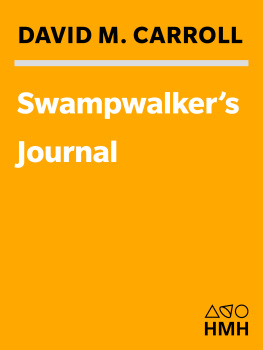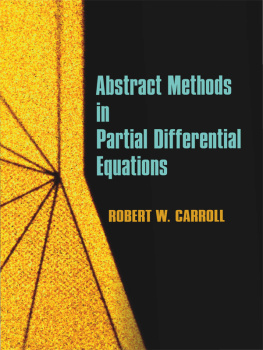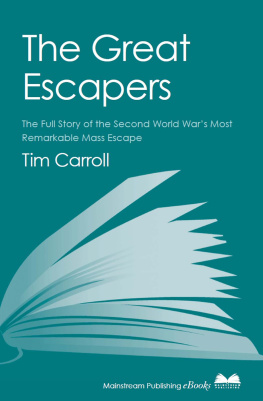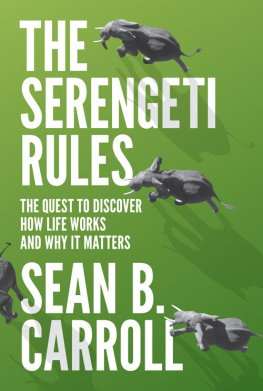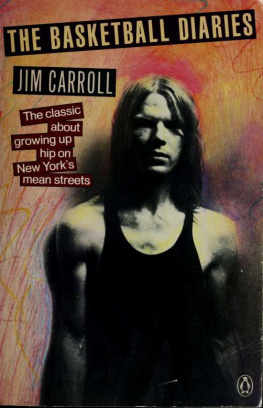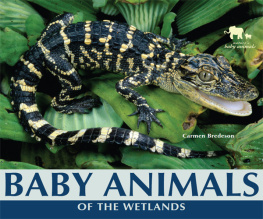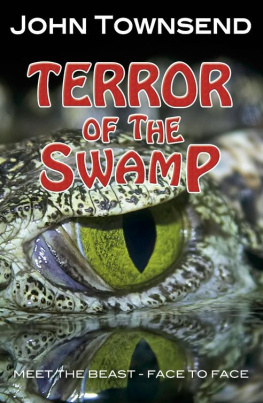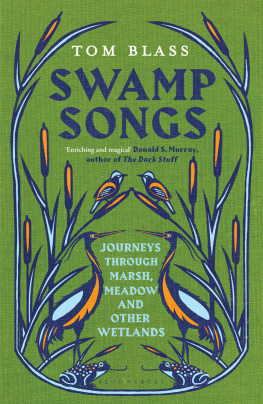Carroll - Swampwalkers journal: a wetlands year
Here you can read online Carroll - Swampwalkers journal: a wetlands year full text of the book (entire story) in english for free. Download pdf and epub, get meaning, cover and reviews about this ebook. City: Boston;New Hampshire, year: 1999, publisher: Houghton Mifflin Harcourt, genre: Detective and thriller. Description of the work, (preface) as well as reviews are available. Best literature library LitArk.com created for fans of good reading and offers a wide selection of genres:
Romance novel
Science fiction
Adventure
Detective
Science
History
Home and family
Prose
Art
Politics
Computer
Non-fiction
Religion
Business
Children
Humor
Choose a favorite category and find really read worthwhile books. Enjoy immersion in the world of imagination, feel the emotions of the characters or learn something new for yourself, make an fascinating discovery.
- Book:Swampwalkers journal: a wetlands year
- Author:
- Publisher:Houghton Mifflin Harcourt
- Genre:
- Year:1999
- City:Boston;New Hampshire
- Rating:4 / 5
- Favourites:Add to favourites
- Your mark:
- 80
- 1
- 2
- 3
- 4
- 5
Swampwalkers journal: a wetlands year: summary, description and annotation
We offer to read an annotation, description, summary or preface (depends on what the author of the book "Swampwalkers journal: a wetlands year" wrote himself). If you haven't found the necessary information about the book — write in the comments, we will try to find it.
Swampwalkers journal: a wetlands year — read online for free the complete book (whole text) full work
Below is the text of the book, divided by pages. System saving the place of the last page read, allows you to conveniently read the book "Swampwalkers journal: a wetlands year" online for free, without having to search again every time where you left off. Put a bookmark, and you can go to the page where you finished reading at any time.
Font size:
Interval:
Bookmark:
First Mariner Books edition 2001
Copyright 1999 by David M. Carroll
All rights reserved
For information about permission to reproduce selections from this book, write to or to Permissions, Houghton Mifflin Harcourt Publishing Company, 3 Park Avenue, 19th Floor, New York, New York 10016.
hmhco.com
Library of Congress Cataloging-in-Publication Data
Carroll, David M.
Swampwalkers journal: a wetlands year / David M. Carroll.
p. cm.
ISBN 10 0-395-64725-8
ISBN 10 0-618-12737-2 (pbk.)
ISBN 13 978-0-618-12737-5
1. WetlandsNew Hampshire. I. Title.
QH 105. N 4 C 27 1999
333.91809742dc21 99-27342 CIP
eISBN 978-0-547-52637-9
v2.0518
For Laurette, Sean, Riana, and Rebecca
This book came to entail more time, pages, and turns in the road than I ever could have foreseen. I am grateful for the gracious patience of my editor, Harry Foster, and Houghton Mifflin Company. I especially thank Harry for his long-term commitment and, in the final stages, his editorial suggestions, which did much to clarify a manuscript in which the author himself became lost on more than one occasion. Peg Andersons attentive, perceptive copy editing greatly assisted the final phase.
I am especially indebted to Brian Butler and Annie Burke for constant and generous soundings as I wrestled with this project and for deep information and perspectives on wetland ecology, evolution, and (of course) turtles. Sheila Tut tie, Margaret Liszka, Todd Aubertin, Edie Hentcy, Sy Montgomery, Gordon Ultsch, Michael Klemens, Carl Ernst, Jim Harding, and Scott Warren have been extremely supportive and have shared sites and/or insights as well as specific information that has been central to my knowledge of turtles and wetlands. A continuing inspiration in my work has come from David Holden, who died at an early age, early in the formation of this hook.
I have been fortunate to come to know and benefit tremendously from other outstanding field workers and wetlands advocates, and I deeply appreciate what they have done for habitat preservation as well as for the evolution of my own project: Margaret Watkins, Jamie Fosburgh, Mark Kern, Judith Spang, Kitty Miller, Joan McKibben, Trudy Loy, Laura Eaton, Anne Tappan, Sara Callaghan, Kim Babbitt, Sally Turtle, Jim Taylor, Barry Wicklow, Jaime Haskins, Alison Whitlock, Joan Milam, Tom Akre, Bill Brown, Nancy Bell, David Mauger, Bern Tryon, Tom Tyning, Brett Stearns, Carol Foss, Amanda Lindley Stone, David Brown, Barry Paterno, David Allan, Heather Behrens, Bill Niering, Laura Deming, Toni McLellan, Gordon Russell, John Kanter, and Rich Cook. Norman Stevens provided unflagging encouragement.
A knowledge of aquatic botany is fundamental to any understanding of wetlands; I have been greatly assisted in this realm by Mary Perry, Dan Sperduto, Rick Van de Poll, and Don Padgett and also helped by Liz Harvey and Frankie Brackley.
During the book years, access to certain lands expanded my range of familiarization with wetlands: special thanks to the Courser and Bates families; to Tupper Hill, Norcross Wildlife Sanctuary; to Fran and Paul Verrette; to the Blickels, Larsons, Fisks, Plumleys, and Chapins; and to Camp Hedding and Tilton Woods.
I also want to thank agencies that provided funding and/or logistical support that helped to keep me in the wetlands and often provided me with valuable new venues as I worked on the book: the National Park Service, the United States Environmental Protection Agency, the Norcross Wildlife Foundation, the Lamprey River Watershed Advisory Committee, the Lamprey River Watershed Association, the Great Bay Partnership, the New England Interstate Water Pollution Control Commission, The Nature Conservancy, and the New Hampshire Department of Environmental Services.
Much appreciation goes to my agent, Meredith Bernstein. And I want to remember here, and thank, some people who go back to the days of my first wet sneakers: Julia Chase, Gordon Ultsch, and Herb Clement.
A final note of deepest appreciation goes out to those researchers I do not know personally but whose work is an ongoing invaluable legacy, freely given, and to all who have labored with great dedication in the exceedingly difficult arena of habitat protection.
Any errors herein are the sole responsibility of the author.
Introduction
1. Vernal Pools
THE REEDGRASS POOL
SALAMANDER RAINS
LIEBESSPIEL
FAIRY SHRIMP
WOOD FROGS
THE FORESTED POOL
ARIADNE
METAMORPHOSIS
MARBLED SALAMANDERS
WINTER POOL
2. The Marsh
THE CROSSING
SNAPPING TURTLE, DRAGONFLY, BLACK BEAR
NEST-TO-WATER JOURNEY
3. The Swamp
SWAMP AT NOON
DEAD-TREE SWAMP
SEEPS, SPRINGS, AND SWAMPS
4. The Shrub Swamp
OPENING
HIGH SUMMER
AFTER FROST
HIBERNACULUM
5. The Pond
FIRST OPEN WATER
HATCHLING
COURTSHIP BALLET
WADING BEAR POND
MIGRATIONS
POND IN THE MAKING
RACCOON AND PAINTED TURTLE
6. The Floodplain
COBBLEBARS, SANDBARS, AND RIVERBANKS
DOWNRIVER
THE OXBOW
THE LEVEE AND THE RIVER CHANNEL
7. Bogs and Fens
BLACK FOX BOG
THE MOAT BOG
CALCAREOUS FEN
TAMARACK BOG
Epilogue
List of Common and Scientific Names
Selected Bibliography
Index
It is my delight and good fortune to have spent a large measure of my life in wetlands. For close to five decades now, from an intuitive boyhood bonding to a more scientific perspective in later years, I have moved among vernal pools, marshes, swamps, floodplains, and peatlands. Later science has done nothing to diminish earlier poetry: answers only unlock questions, and specific knowledge only deepens the mystery of the earths landscape and life. As a boy, ! knew ponds and swamps and streams; if the word wetland had been coined, it was of rare or specialized usage, and I never heard it. Today one can hardly glance at a newspaper or a television program without encountering the term. Magnificent even in their present broken and besieged state, wetlands have become arenas of intense human debate.
My focus has always been freshwater wetlands, and that focus has led to this book. Each year I head out to the pools, marshes, and swamps at thaw, always with a particular eye out for turtles, and I stay there for as many hours of as many days as possible, until the ice returns. This long, wonderful season generally extends from late March to late November or into December in my home wetlands in New Hampshire. My intent in this book is to take the reader through some of my rounds and to convey aspects of what I see and experience over the cycle of the seasons. There is so much to be seen, even in a little vernal pool, let alone in a rivers great floodplain, that any account is necessarily limited. I introduce the hydrology and structure of various wetland types and a range of the plants and animals typical of each.
The wetlands I describe are in the glaciated Northeast, though I do refer to other parts of the United States and Canada. In each chapter I enter a different kind of wetland and attempt to describe something of its defining essence, mindful that marshes, swamps, fens, and the like are elusive entities, that they mingle among and shade into one another as well as into the surrounding uplands. My hope is that the reader will gain a feeling of familiarity with these habitats that will engender a deeper, more personal appreciation and awareness of them and perhaps inspire work toward their preservation, which is so critically needed.
The foundation of my writing and drawing is personal experience, my being there, and what I have learned from having been there through so many epochs of my life. Over the past decade this experience has been greatly augmented by readings of the literature and by dialogues with other field workers, to whom I am much indebted. But my greatest debt is to the wetlands and to the turtles who first led me there and who keep me there today. Though all wetlands are tragically diminished and under incredible pressure in the human-serving modern landscape, what they hold can still be found, often surprisingly close at hand. Moments outside of the human world in the shallows of a marsh, with red-winged blackbirds calling and the wind rustling in cattails or reedgrass, or a solitary spell at the edge of a swamp on the edge of winterthese will bring intimations of the spirit that moves with the water, the light, and the life of the marsh.
Font size:
Interval:
Bookmark:
Similar books «Swampwalkers journal: a wetlands year»
Look at similar books to Swampwalkers journal: a wetlands year. We have selected literature similar in name and meaning in the hope of providing readers with more options to find new, interesting, not yet read works.
Discussion, reviews of the book Swampwalkers journal: a wetlands year and just readers' own opinions. Leave your comments, write what you think about the work, its meaning or the main characters. Specify what exactly you liked and what you didn't like, and why you think so.

